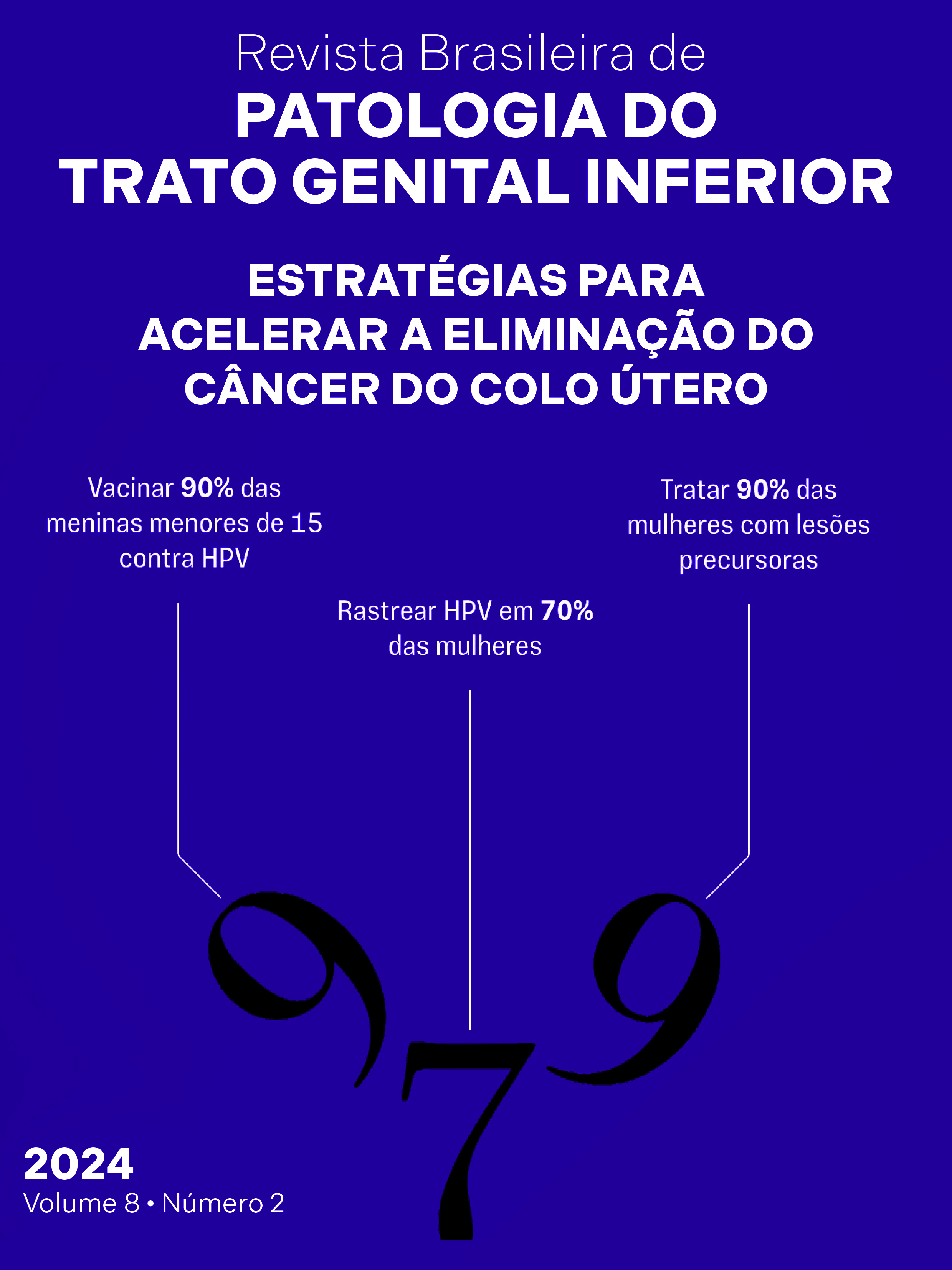How do I manage vaginal intraepithelial neoplasia?
DOI:
https://doi.org/10.5327/2237-4574-2024820011Keywords:
vaginal neoplasms, treatment outcome, local neoplasm recurrenceAbstract
Vaginal intraepithelial neoplasia is a precursor lesion of vaginal carcinoma. It is a rare finding, with human papillomavirus
infection as its main aetiological factor. Diagnosis is made by cytology, colposcopic examination, and histopathology, considered
the gold standard. The disease has invasive potential and requires treatment. No single therapeutic approach is suitable for all
presentations, but several treatment modalities are available. The therapeutic arsenal consists of excisional surgical alternatives,
destructive treatments, and clinical approach. Follow-up of these lesions should be conducted according to the guidelines
established for cervical intraepithelial diseases.
References
Bogani G, Martinelli F, Ditto A, Taverna F, Lombardo C, Signorelli M,
et al. Human papillomavirus persistence and HPV 31 predict the
risk of recurrence in high-grade vaginal intraepithelial neoplasia.
Eur J Obstet Gynecol Reprod Biol. 2017;210:157-65. https://doi.
org/10.1016/j.ejogrb.2016.12.020
Vinokurova S, Wentzensen N, Einenkel J, Klaes R, Ziegert C, Melsheimer
P, et al. Clonal history of papillomavirus-induced dysplasia in the
female lower genital tract. J Natl Cancer Inst. 2005;97(24):1816-21.
https://doi.org/10.1093/jnci/dji428
Brinton LA, Nasca PC, Mallin K, Schairer C, Rosenthal J, Rothenberg R,
et al. Case-control study of in situ and invasive carcinoma of the vagina.
Gynecol Oncol. 1990;38(1):49-54. https://doi.org/10.1016/0090-
(90)90010-i
Indraccolo U, Baldoni A. A simplified classification for describing
colposcopic vaginal patterns. J Low Gen Trac Dis. 2012;16(2):75-9.
https://doi.org/10.1097/LGT.0b013e318237ec82
Sopracordevole F, Mancioli F, Clemente N, De Piero G, Buttignol M,
Giorda G, et al. Abnormal pap smear and diagnosis of high- grade
vaginal intraepithelial neoplasia: a retrospective cohort study.
Medicine (Baltimore). 2015;94(42):e1827. https://doi.org/10.1097/
MD.0000000000001827
Gagné HM. Colposcopy of the vagina and vulva. Obstet Gynecol
Clin North Am. 2008;35(4):659-69; x. https://doi.org/10.1016/j.
ogc.2008.10.002
Gurumurthy M, Cruickshank M. Management of vaginal intraepithelial
neoplasia. J Low Genit Tract Dis. 2012;16(3):306-12. https://doi.
org/10.1097/LGT.0b013e31823da7fb
Sopracordevole F, Moriconi L, Di Giuseppe J, Alessandrini L, Del Piero
E, Giorda G, et al. Laser excisional treatment for vaginal intraepithelial
neoplasia to exclude invasion: what is the risk of complications?
J Low Genit Tract Dis. 2017;21(4):311-4. https://doi.org/10.1097/
LGT.0000000000000326
Zanine RM. Neoplasia intraepitelial vaginal. In: Primo W, Valença J,
orgs. Doenças do trato genital inferior. São Paulo: Elsevier; 2016.
p. 137-46.
Kelsic V, Carcopino X, Preti M, Vieira-Batista P, Bevilacqua F, Bornstein
J, et al. The European Society of Gynaecologycal Oncology (ESGO),
The International Society for the Study of Vulvo vaginal Disease
(ISSVD), the European College for the Study of Vulval Disease
(ECSUD), and the European Federation for Colposcopy (EFC) consensus
statement on the management of vaginal intraepithelial neoplasia.
Int J Gyenecol Cancer. 2023:33(4):446-61. https://doi.org/10.1136/
ijgc-2022-004213
Hoffman M. Vaginal intraepithelial neoplasia: risky and underrecognized.
OBG Management. 2004;16(6):29-41.
Atay V, Muhcu M, Çaliskan AC. Treatment of vaginal intraepithelial
neoplasia. Cancer Therapy. 2007;5(1):19-27.
Dodge JA, Eltabbakh GH, Mount SL, Walker RP, Morgan A. Clinical
features and risk of recurrence among patients with vaginal
intraepithelial neoplasia. Gynecol Oncol. 2001;83(2):363-9. https://
doi.org/10.1006/gyno.2001.6401
Blanchard P, Monnier L, Dumas I, Morice P, Pautier P, Duvillard P,
et al. Low-dose definitive brachytherapy for high-grade vaginal
intraepithelial neoplasia. Oncologist. 2011;16(2):182-8. https://doi.
org/10.1634/theoncologist.2010-0326
Tranoulis A, Laios A, Mitsopoulos V, Lutchman-Singh K, Thomakos N.
Efficacy of 5% imiquimod for the treatment of vaginal intraepithelial
neoplasia-a systematic review of the literature and a meta-analysis.
Eur J Obstet Gynecol Reprod Biol. 2017;218:129-36. https://doi.
org/10.1016/j.ejogrb.2017.09.020
Tainio K, Jakobsson M, Louvanto K, Kalliala I, Paavonen J, Nieminen
P, et al. Randomised trial on treatment of vaginal intraepithelial
neoplasia- imiquimode, laser vaporization and expectant management.
Int J Cancer. 2016:139 (10): 2353-8. https://doi.org/10.1002/ijc.30275
Gonzalez-Sanchez JL, Flores-Murrieta G, Deolarte-Melgarejo JM, RiosMontiel FA, Hernandez-Manzano A. Effectiveness of 5-Fluorouracil
in the treatment of vaginal intraepithelial neoplasia in a mexican
population. J Low Genit Tract Dis. 1998;2(4):221-4. https://doi.
org/10.1097/00128360-199810000-00007
Fiascone S, Vitonis A, Feldman S. Topical 5-Fluorouracil for
women with hogh-grade vaginal intraepithelial neoplasia.
Obstet Gynecol. 2017;130(6):1237-43. https://doi.org/10.1097/
AOG.0000000000002311

